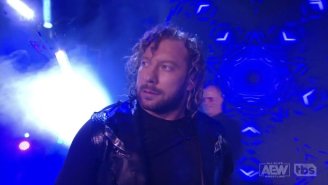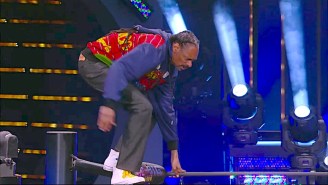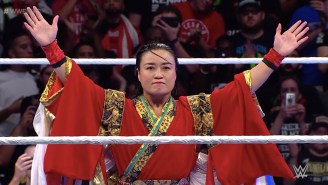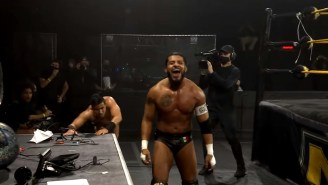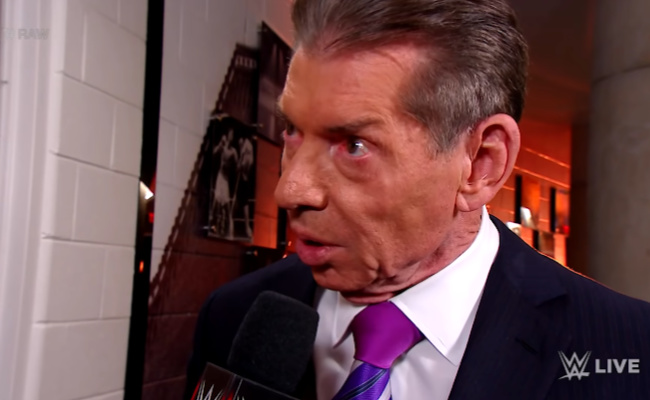
WWE is being prominently featured once again in the venerable entertainment trade publication Variety, which seems like something that Vince McMahon would be happy about, since he loves seeing WWE is an entertainment company first and foremost. However, unlike previous positive attention they’ve given McMahon and his company, today they published a piece that lays out the recent problems WWE is having as an entertainment company, and how hard it’s going to be this time for Vince to persuade shareholders that things are about to turn around.
From the new editorial by Gavin Bridge:
McMahon will also have to offer some kind of hope to investors given how badly WWE stock has been slumping since Q1, closing Friday 29% down against the 2019 high of $99. The company’s TV partners, NBCUniversal and Fox, are also reportedly getting anxious about the state of the WWE, having paid a combined $2.35 billion earlier this year to keep “Raw” and “SmackDown” on the air for five more years.
The networks haven’t said anything publicly expressing concern, but the data demonstrates they have every right to be worried.
As Bridge goes on to point out, it’s not that nobody is watching Raw and Smackdown, it’s just that less and less people want to watch those shows, compared to how many people used to.
The total audience for “Raw” plummeted 20% over the first half of the year compared with the same period in 2018, losing an average of 616,000 viewers per episode. “SmackDown” is down almost as much, registering a 17% drop, shedding 446,000 viewers. WWE is still one of the most watched cable shows on Monday and Tuesday, but the year-over-year declines represents an accelerating downturn compared with 2018 versus 2017, when the difference was negligible.
WWE continues to have problems attracting fans, and as the efforts to turn things around get more and more blatant, the problem becomes a spiral.
McMahon had pinned his hopes on WWE getting a shot in the arm from the April 7th edition of WrestleMania, which typically sets a new season of storylines for the following year on “Raw” and “Smackdown.” But the pivotal episodes of both shows that aired shortly after WrestleMania—typically among the highest rated of the year—were down 25% on “Raw” and 26% on “SmackDown.”
There’s been several attempts in recent months to re-engage viewers but to no avail, with on-air promises to listen to fans more, the storyline implementation of a ‘wild card’ rule allowing wrestlers to appear on multiple shows in the same week, and the introduction of a new championship in May all failing to bring viewers back. No wonder McMahon in June enlisted two of the most experienced wrestling showrunners in the business, Eric Bischoff and Paul Heyman, to run “SmackDown” and “Raw,” respectively, reporting directly to him.
McMahon has yet to publicly comment on the hires. But it’s an important indicator that WWE is finally focused on its biggest problem: the creative.
Critics and former WWE talent have been negative about the direction of “Raw” and “SmackDown” for some time, and it ratings corroborate these sentiments. WWE investors better hope McMahon’s new behind-the-scenes tag team will be able to reinvigorate the storylines for WWE’s talent and recover some of the lost audience.
Ultimately what this seems to come down to is that WWE’s product just isn’t very good right now. Most of us agree on that, and we discuss it constantly on web sites like this one. But as the problem increases its effect on the business side of the business, and it becomes ever more obvious to people outside our little wrestling bubble, it’s harder and hard to see how WWE can fix it without even acknowledging the problem is real.
The stakeholder unease comes at a time when WWE is facing a decline not only in TV ratings, but in live event attendance and merchandise spend. With the last WWE pay-per-view-event for Q2 reportedly seeing markedly lower than usual attendance levels, it’s high time for McMahon to get candid about the fragile state of his core product.
The full editorial is worth a read. It goes into detail about Vince’s previous “superstar absences” excuses, and how little water they hold. There are even detailed charts.

